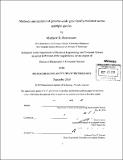| dc.contributor.advisor | Manolis Kellis. | en_US |
| dc.contributor.author | Rasmussen, Matthew D. (Matthew David) | en_US |
| dc.contributor.other | Massachusetts Institute of Technology. Dept. of Electrical Engineering and Computer Science. | en_US |
| dc.date.accessioned | 2011-04-25T15:58:00Z | |
| dc.date.available | 2011-04-25T15:58:00Z | |
| dc.date.copyright | 2010 | en_US |
| dc.date.issued | 2010 | en_US |
| dc.identifier.uri | http://hdl.handle.net/1721.1/62433 | |
| dc.description | Thesis (Ph. D.)--Massachusetts Institute of Technology, Dept. of Electrical Engineering and Computer Science, 2010. | en_US |
| dc.description | Cataloged from PDF version of thesis. | en_US |
| dc.description | Includes bibliographical references (p. 123-136). | en_US |
| dc.description.abstract | The fields of genomics and evolution have continually benefited from one another in their common goal of understanding the biological world. This partnership has been accelerated by ever increasing sequencing and high-throughput technologies. Although the future of genomic and evolutionary studies is bright, new models and methods will be needed to address the growing and changing challenges of large-scale datasets. In this work, I explore how evolution generates the diversity of life we see in modern species, specifically the evolution of new genes and functions. By reconstructing the history of the diverse sequences present in modern species, we can improve our understanding of their function and evolutionary importance. Performing such an analysis requires a principled and efficient means of computing the most probable evolutionary scenarios. To address these challenges, I introduce a new model of gene family evolution as well as a new method SPIMAP, an efficient Bayesian method for reconstructing gene trees in the presence of a known species tree. We observe many improvements in reconstruction accuracy, achieved by modeling multiple aspects of evolution, including gene duplication and loss rates, speciation times, and correlated substitution rate variation across both species and loci. I have implemented and applied this method on two clades of fully-sequenced species, 12 Drosophila and 16 fungal genomes as well as simulated phylogenies, and find dramatic improvements in reconstruction accuracy as compared to the most popular existing methods, including those that take the species tree into account. Lastly, I use the SPIMAP method to reconstruct the evolutionary history of all gene families in 16 fungal species including several relatives of the pathogenic species C. albicans. From these reconstructions, we identify several families enriched with duplications and positive selection in pathogenic lineages. Theses reconstructions shed light on the evolution of these species as well as a better understanding of the genes involved in pathogenicity. | en_US |
| dc.description.statementofresponsibility | by Matthew D. Rasmussen. | en_US |
| dc.format.extent | 136 p. | en_US |
| dc.language.iso | eng | en_US |
| dc.publisher | Massachusetts Institute of Technology | en_US |
| dc.rights | M.I.T. theses are protected by
copyright. They may be viewed from this source for any purpose, but
reproduction or distribution in any format is prohibited without written
permission. See provided URL for inquiries about permission. | en_US |
| dc.rights.uri | http://dspace.mit.edu/handle/1721.1/7582 | en_US |
| dc.subject | Electrical Engineering and Computer Science. | en_US |
| dc.title | Methods and analysis of genome-scale gene family evolution across multiple species | en_US |
| dc.type | Thesis | en_US |
| dc.description.degree | Ph.D. | en_US |
| dc.contributor.department | Massachusetts Institute of Technology. Department of Electrical Engineering and Computer Science | |
| dc.identifier.oclc | 710994361 | en_US |
